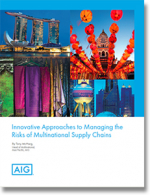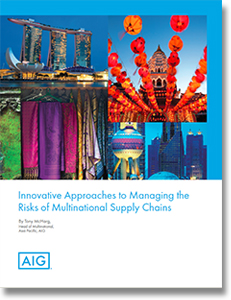Innovative Approaches to Managing the Risks of Multinational Supply Chains
Managing supply chain risks is critical to the success of a business, and perhaps most critical in Asia Pacific with its high growth rate, shifting industry trends, increasingly sophisticated consumers and businesses rapidly expanding into the region.
The Asia-Pacific Economic Cooperation (APEC) is also getting ready for closer ties and bigger trade flows among member-countries when tariffs are reduced by the end of 2015.
Both nominal Gross Domestic Product (GDP) and total exports for Asia have more than doubled in the last 10 years, illustrating this rapid growth. Nominal GDP for 2015 is expected to reach more than US$23 trillion and total exports US$6 trillion as growth continues.
If we look at data for the top 15 countries in the world which import and export intermediate goods, nine of those countries are in Asia Pacific. These include China, Japan, Korea, Hong Kong, Singapore and Australia.
But while Asia’s economies are expanding rapidly so too are the risks to companies’ supply chains based here.
One example is natural disasters (such as the recent earthquake in Nepal and typhoon in The Philippines) which are becoming more expensive as the cost of living rises in these countries along with their GDPs.
Another increasing problem is cyber risk as our use of technology grows along with our connectivity. Big data is a good example of this changing risk. While it enables a new source of customer intimacy and competitive advantage, protecting that data involves added risks.
Responding to this shifting landscape, AIG recently brought together a distinguished panel of industry experts in Singapore on 29 April 2015 to explore innovative approaches to managing supply chain risk. The panel included a leading management consultant, an expert in banking industry risk and a renowned logistics academic.
The emphasis was on how innovations will help companies tackle their supply chain issues by predicting problems before these arise.
The experts agreed that supply chain disruption can have a devastating effect on a company such as tarnished brand, loss of customers and an overall fall in revenues and share price.
All of these can affect market share, liquidity and the ability to secure financing, if not resolved quickly and efficiently. But despite these huge implications, many companies are not devoting enough resources to safeguarding their supply chains.
Supply Chains Growing Deeper
As the world becomes more connected, supply chains are becoming longer, spread over more countries and creating even more risk. The risks are continually evolving as new business trends emerge.
For example, low-cost manufacturing is beginning to shift away from China’s coastal areas to inland provinces.
This means the risks to export goods in transit are greatly increased as thousands of miles are added to their routes.
Jerry Dimos, Partner, Management Consulting for ASEAN at KPMG, said: ‘’Many companies don’t devote the time and effort to understanding and mitigating their risks.
What’s Related


Favorites





